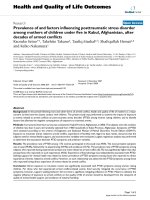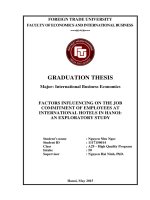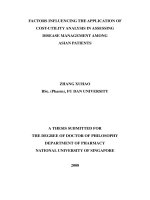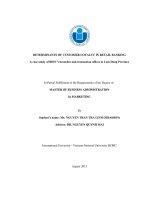Factors influencing local customer loyalty, case low cost airline vietjet air in vietnam
Bạn đang xem bản rút gọn của tài liệu. Xem và tải ngay bản đầy đủ của tài liệu tại đây (943.89 KB, 81 trang )
FACTORS INFLUENCING LOCAL CUSTOMER LOYALTY,
CASE: LOW COST AIRLINE VIETJET AIR IN VIETNAM
In Partial Fulfillment of the Requirements of the Degree of
MASTER OF BUSINESS ADMINISTRATION
In International Business
By
Mr: Đoàn Giang Sơn
ID: MBA04033
International University - Vietnam National University HCMC
September 2013
FACTORS INFLUENCING LOCAL CUSTOMER LOYALTY,
CASE: LOW COST AIRLINE VIETJET AIR IN VIETNAM
In Partial Fulfillment of the Requirements of the Degree of
MASTER OF BUSINESS ADMINISTRATION
In International Business
by
Mr: Doan Giang Son
ID: MBA04033
International University - Vietnam National University HCMC
September 2013
Under the guidance and approval of the committee, and approved by all its members, this
thesis has been accepted in partial fulfillment of the requirements for the degree.
Approved:
---------------------------------------------Chairperson
--------------------------------------------Advisor
---------------------------------------------Committee member
--------------------------------------------Committee member
---------------------------------------------Committee member
--------------------------------------------Committee member
Acknowledge
To complete this thesis, I have been benefited from many people around me.
First of all, I specially thank my advisor, Mr. Ho Nhut Quang, for guiding me
patiently to complete the thesis. His information and advice are very valuable not only
for this research but also for my real life. Thank you with all of my honors.
Next, I would like to thank all of teachers in MBA department of IU, who
gave me a lot of knowledge in business field. It is lucky for me when I have been
trained by professional teachers in professional environment. Their experience and
knowledge always make me admire.
Finally, I am very thankful to my family and friends, who always support and
encourage me to pass all of difficulties in the periods of studying MBA program.
Plagiarism Statements
I would like to declare that, apart from the acknowledged references, this
thesis either does not use language, ideas, or other original material from anyone; or
has not been previously submitted to any other educational and research programs or
institutions. I fully understand that any writings in this thesis contradicted to the above
statement will automatically lead to the rejection from the MBA program at the
International University – Vietnam National University Hochiminh City.
Copyright Statement
This copy of the thesis has been supplied on condition that anyone who
consults it is understood to recognize that its copyright rests with its author and that
no quotation from the thesis and no information derived from it may be published
without the author’s prior consent.
© Đoàn Giang Sơn/ MBA04033/2013
Contents
Chapter One - Introduction .......................................................................................... 1
1. Introduction .......................................................................................................... 1
1.1. Background ...................................................................................................... 1
1.2. Rationale of research ........................................................................................ 2
1.3. The problem statement ..................................................................................... 3
1.4. Research question ............................................................................................. 3
1.5. Research objectives .......................................................................................... 3
1.6. Research scope: ................................................................................................ 4
2.2 Conceptual Model of the thesis study ............................................................... 4
3. Research methodology ......................................................................................... 5
3.1 Research Framework ......................................................................................... 5
4. Significant of the research .................................................................................... 7
5. Propose structure .................................................................................................. 7
Chapter Two - Literature review .................................................................................. 9
1. Previous models ................................................................................................... 9
2. Perceived Value .................................................................................................. 12
3. Price .................................................................................................................... 13
4. Service Quality ................................................................................................... 14
5. Brand Image: ...................................................................................................... 15
6. Trust.................................................................................................................... 16
7. Customer satisfaction ......................................................................................... 17
8. Customer loyalty ................................................................................................ 19
8.1 Customer loyalty definition ............................................................................. 19
8.2 The influences of customer loyalty on firm‟s incomes. .................................. 19
9. Research model and Hypotheses ........................................................................ 21
Chapter Three - Methodology .................................................................................... 23
1. Research Method ................................................................................................ 23
2. Primary data collection ....................................................................................... 24
2.1 Paper survey as the data collection method ..................................................... 24
2.2 Questionnaire design and data collection ........................................................ 25
3. Reliability and Validity ...................................................................................... 26
3.1 Reliability test.................................................................................................. 26
3.2 Validity test ..................................................................................................... 26
Chapter Four - Data analysis and Research results .................................................... 30
1. Sample description ............................................................................................. 30
2. Descriptive statistic ............................................................................................ 31
2.1 Price ................................................................................................................. 31
2.2 Perceived Value ............................................................................................... 32
2.3 Service Quality ................................................................................................ 32
2.4 Brand Image .................................................................................................... 33
2.5 Trust................................................................................................................. 34
2.6 Customer Satisfaction...................................................................................... 34
2.7 Customer Loyalty ............................................................................................ 35
3. Reliability tests ................................................................................................... 36
4. Validity tests ....................................................................................................... 36
4.1 Tests for 1st stage ............................................................................................ 36
4.2 Tests for 2nd Stage .......................................................................................... 43
5. Path Analysis ...................................................................................................... 48
5.1 Influence of Customer Loyalty: H1d, H2d and H3d tests .................................. 48
5.2 Indirect influence path analysis ....................................................................... 49
Chapter Five - Conclusions and Recommendations .................................................. 53
1. Conclusion .......................................................................................................... 53
2. Suggestions for Vietjet Air ................................................................................. 54
2.1 Price policy. ..................................................................................................... 54
2.2 Service quality. ................................................................................................ 55
2.3 Brand Image .................................................................................................... 56
3. Limitation ........................................................................................................... 56
LIST OF REFERENCES ........................................................................................... 57
APPENDIX A ............................................................................................................ 63
APPENDIX B ............................................................................................................ 66
LIST OF FIGURE
Figure 1: Schematic diagram of research ..................................................................... 5
Figure 2: Research framework ..................................................................................... 6
Figure 3: European Customer Satisfaction Model ....................................................... 9
Figure 4: Model of impacts on Customer Loyalty in commercial airlines industry .. 10
Figure 5: Model of Steven A. Taylor in marketing of heavy equipment ................... 10
Figure 6: SERVQUAL Model ................................................................................... 12
Figure 7: Conceptual research model ......................................................................... 21
Figure 8: Questionnaire design .................................................................................. 25
Figure 9: Respondent gender description ................................................................... 30
Figure 10: Final research model................................................................................. 51
LIST OF TABLE
Table 4.1: Number of flight that respondents made with VJ ..................................... 30
Table 4.2: Number of flights that respondents made in one year .............................. 31
Table 4.3: Price descriptive statistic........................................................................... 31
Table 4.4: Perceived Value descriptive statistic ........................................................ 32
Table 4. 5: Service quality descriptive statistic .......................................................... 32
Table 4.6: Brand image descriptive statistic .............................................................. 33
Table 4.7: Trust descriptive statistic .......................................................................... 34
Table 4.8: Customer satisfaction descriptive statistic ................................................ 34
Table 4.9: Customer loyalty descriptive statistic ....................................................... 35
Table 4.10: the Cronbach‟s Alpha of factors ............................................................. 36
Table 4.11: KMO and Barlett‟s test for Independent variables ................................. 37
Table 4.12: Total variance Explained for 1st Stage .................................................... 37
Table 4.13: Rotated component matrix for 1st Stage.................................................. 38
Table 4.14: Correlation between indirect factors and direct factors .......................... 39
Table 4.15: R-square value in H1a, H2a, H3a test ........................................................ 40
Table 4.16: ANOVA in H1a, H2a, H3a test .................................................................. 40
Table 4.17: Coefficients values in H1a, H2a, H3a test .................................................. 40
Table 4.18: R-square Value in H1b, H2b, H3b test ....................................................... 41
Table 4.19: ANOVA in H1b, H2b, H3b test .................................................................. 41
Table 4.20: Coefficients in H1b, H2b, H3b test............................................................. 42
Table 4.21: R-square value in H1c, H2c, H3c test ........................................................ 42
Table 4.22: ANOVA in H1c, H2c, H3c test .................................................................. 42
Table 4.23: Coefficients in H1c, H2c, H3c test ............................................................. 43
Table 4.24: KMO and Barlett‟s Test for 2nd Stage..................................................... 43
Table 4.25: Total Variance Explained for 2nd Stage .................................................. 44
Table 4.26: Rotated Component Matrix for 2nd Stage ............................................... 45
Table 4.27: Correlations between TRU, CSA, BRI and LYT ................................... 46
Table 4.28: R-square value between TRU, CSA, BRI and LYT ............................... 47
Table 4.29: ANOVA between TRU, CSA, BRI and LYT ......................................... 47
Table 4.30: Coefficients between TRU, CSA, BRI and LYT .................................... 47
Table 4.31: Coefficients between indirect factors and Customer Loyalty ................. 48
Table 4.32: Interpreting Strength of Path Coefficients .............................................. 50
Table 4.33: Evaluate the relationship between influence factors and Customer
Loyalty ....................................................................................................................... 51
Table 4.34: Hypothesis testing result ......................................................................... 52
Abstract
This study was conducted in order to evaluate the influence of relevant factors on
Customer Loyalty of Vietnam low cost airline, VietjetAir. The direct factors and indirect
factors influencing loyalty of customer are defined and be built as an airline customer
loyalty model. The quantitative method was used as the key method with the assistance
of statistical instrument. To achieve the primary data, customers of VietjetAir were
asked to fill in the paper survey; and their remarks would be the valuable contribution
for the research completion. Finally, through this research, VietjetAir may figure out
their gaps and also their strong points which help them bring out the suitable actions to
win the customer loyalty, an important determinant in today business.
Chapter One - Introduction
1. Introduction
1.1. Background
Vietjetair operated its first flight in the late December 2011. After more than a
year, Vietjetair has got approximate 16% market share, and it is standing higher than
Jetstar Pacific (13%) and Air Mekong (3%). (Source: To Ha, Laborer‟s Newspaper,
2013). In the beginning, Vietjetair had 3 airplanes and now it has 6 with many domestic
destinations as: Hochiminh, Nha Trang, Hanoi, Phu Quoc, Da Nang, Hai Phong, Hue,
Vinh, Cam Ranh and 1 foreign route to Bagkok. It is an amazing development in the
year of economic crisis 2012.
Vietjetair was established by 3 main shareholders: T&C group, Sovico Holdings
and Bank for Investment and Development of Vietnam JSC (BIDV) with the initial
capital is 600 billions VND. Vietjetair Corporatin was got the license to flight from the
Major of Ministry of Transport in 2007. In the first plan, Vietjetair intended to operate
first flight in 2008. But due to many reasons such as fuel fluctuation and brand
disputation, Vietjetair had to postpone opening flights. After a few times delay,
Vietjetair operated its first flights from Hochiminh to Hanoi in 25th December 2011 as
requirement of Ministry of transport.
When Vietjetair stepped into air transport industry, there are total 5 commercial
airlines which serve in domestic routes. They are Vietnam Airline, Jetstar Pacific,
Airmekong, VASCO and Vietjetair. Therefore, the competition between those Airlines
have being increased and more fierce. Air Mekong with the incorrect strategy decided to
stop flying in late February 2013. It cannot continue maintaining the loss-making
operation and Airmekong is the second looser in air transport industry after Indochina
Airline.
1
Vietjetair is going in different way. It learned the model from one of the most
successful low cost airline, AirAsia, to be its loadstar. And Vietjetair is the second low
cost airline of Vietnamese market beside Jetstar Pacific.
1.2. Rationale of research
The concept of customer loyalty was given by Oliver, 1999 is: “a deeply held
commitment to rebury or repatronize a preferred product/ service consistently in the
future, thereby causing repetitive same brand or same brand set purchasing, despite
situational influences and marketing efforts having the potential to cause switching
behavior”.
There are some major benefits of customer loyalty. First, loyal customers are
repeat customers. They will return to buy product/service again and again. It means that,
they will bring the steady income for company which sell product or supply service.
Moreover, loyal customer will introduce product/service to his family, friends… and it
brings more benefit to business. Second, the company does not have to spend much
money to advertise the product to loyal customers. And the loyal customers are willing
to ignore small mistake causing by supplier.
In commercial air transport, winning the customer‟s loyalty is also very
important. There are many strong competitors who always try to build their brands,
giving reasonable ticket price, improve service… to win market share. The 2 previous
samples of Indochina Airline and Airmekong had to stop their business because they
could not keep passengers stay with them. Realize the lessons from previous Airlines,
Vietjetair are trying more and more to win the loyalty from customers.
2
1.3. The problem statement
The economy is still in the difficult periods, the fuel price is not stable, the
competition is more and more fierce. Vietjetair has to face many problems. But the
biggest issue now is that the number of consumers that uses Vietjetair more than one
time is going down (Source: Vietjetair Annual report, 2012). The Board of Director of
Vietjetair recognizes the issue and they are determined to find out the reasons why that
issue occurs. Besides that, after a year operating, they also want to have a research to
examine the factors which influence the customer‟s satisfaction, customer‟s perception
and their loyalty with Vietjetair.
Due to those reasons above, I decided to choose the topic for my thesis:
“FACTORS INFLUENCING THE LOCAL CUSTOMER’S LOYALTY
– CASE: VIETNAMESE LOW COST AIRLINE VIETJETAIR IN VIETNAM”
1.4. Research question
After defining the research problem, this thesis is going to follow with research
question:
“What factors influence the local customers‟ loyalty of the Vietnamese low
cost airline, Vietjetair?”
1.5. Research objectives
1.5.1 General Objective
This research will identify the factors which influence the loyalty of the Vietjet
Air‟s local customers.
3
1.5.2 The specific objectives:
First, the thesis is going to review the theories, previous researches and building
the conceptual model for the study.
Second, identify the direct and indirect factors which have impact on the
consumer‟s loyalty of Vietjetair.
Third, analyze the result and point out recommendations for airline.
1.6. Research scope:
- This research will focus on the Vienamese passengers, who have already used
the service of Vietjetair. The foreigners are not participating in the survey due to
different culture and level of awareness.
- All the secondary data related to Vietjetair will be collected from the December
2011, the day that airline started its first flight.
- In this research, the survey will be used and it is going to implement only in
Tan Son Nhat Airport. Because in this area, there are thoundsands of passengers waiting
for their flights a day; therefore it is easier for author to collect survey and it does not
cost much.
- The research will not count every type of ages of customer. Author chooses the
customers in ages from 18 to 55, because these type of passengers frequently travel and
they have enough perception and apprehension after using a service.
2.2 Conceptual Model of the thesis study
After searching and reading some models concerning about the thesis, a new
model which is the combination between some factors and their relationships is created
as the figure below. Base on this framework, a small research will be conducted to
clarify the influence of the related factors to the customer loyalty in this thesis. There are
4
3 direct impacts on Customer loyalty: Trust, Brand Image and Customer Satisfaction
and 3 indirect impacts on Customer loyalty: Price, Perceived Value, Service quality.
Price
Trust
Service
Quality
Brand Image
Perceived
Value
Customer
Satisfaction
Customer
Loyalty
Figure 1: Schematic diagram of research
3. Research methodology
3.1 Research Framework
After defining the problem statement, the research objectives were established in
three parts: review theories and build the conceptual model, identify the factors that
have impact on customer loyalty and analyze the results.
5
Problem
Statement
Research Objectives
Review theories and
build conceptual model
Collect secondary data
Descriptive analysis
Identify factors that
influence customer
loyalty
Qualitative Method
Quantitative Method
Findings
Conclusion &
Recommendation
Figure 2: Research framework
Review theories and build the conceptual model: collecting the secondary data
and descriptive analysis are the methods for this part. There are a lot of theories,
definitions, previous researches… in books, internet, magazines, articles… so it is
convenient to read and collect the information from those sources.
Identify factors that influence customer loyalty: in this part, both qualitative and
quantitative methods are used. The primary data will be made by doing the management
interview and survey. The questionnaires will be sent to respondents to explore their
opinions about Vietjetair. After getting the feedback from respondents, the information
is put on the statistic tool (SPSS) and the results are shown.
6
Analyze the results: when seeing the result after running SPSS, the analysis is
conducted to point out some findings. Furthermore, the analysis will answer the very
important question: “Is this research reliability and validity?”
Conclusions and recommendations: this is the final step in the research.
Depending on the result analysis, it is easy to find out which factors have affect
customer loyalty. Hence, the conclusions and recommendations will be exposed to help
airline improve their operations to win customer loyalty.
4. Significant of the research
First of all, the research will help Vietjetair Corporation determine the factors
which have influence on the customer‟s loyalty. It also assists the company to recheck
the quality of current service programs. Then, it will orient the marketing plans which
focus on the customer‟s loyalty effectively.
This study also is a great chance for me to take part in a real research. It will help
me to improve the research skill, learn more knowledge, and experience the new steps in
studying, collecting data and analyzing data.
5. Propose structure
CHAPTER I: INTRODUCTION
The chapter I will overview the background of research. Then, it will show
the reasons to choose topic, the research problem statement, the objectives and research
question, the scope of research, brief methodology and conceptual framework
CHAPTER II: LITERATURE REVIEW
In chapter II, there are concepts and definitions of the research objectives.
The reviewing similar previous researches and proposing the theoretical framework
related to are also included.
7
CHAPTER III: METHODOLOGY
This chapter will present the method which are used to achieve all the
research objectives and answering the research questions. This chapter begins with
research design, followed by the primary data and secondary data collection, qualitative
and quantitative design, questionnaire design and data analysis. Statistical tools (SPSS)
will be used in the research.
CHAPTER IV: ANALYSE THE RESULTS
When receiving the results by running SPSS, this chapter will examine the
reliability and validity of the survey. Finally, the results of the test help to answer the
research question.
CHAPTER V: CONCLUSION AND RECOMMENDATION
This final chapter will give out conclusions after seeing the result of the data
analysis and the investigation of the influence of factors on Customer Loyalty will be
clear. Moreover, base on the research question, this chapter will provide few
recommendations for Airline.
8
Chapter Two - Literature review
1. Previous models
In this part, some models are mentioned as the references for the thesis
conceptual framework.
European customer satisfaction index
Figure 3: European Customer Satisfaction Model
This model is the famous one in Europe. This model, Ball et al. believed that
customer satisfaction is the concurrent impact of factors: image, perceived value,
perceived quality and expectation. He explained the customer loyalty of a product or a
service through the customer satisfaction index when it is directly or indirectly
influenced by those factors.
Andreas H. Zins, 2001
9
Figure 4: Model of impacts on Customer Loyalty in commercial airlines industry
In the book of International Journal of Service Industry Management, Andreas
H. Zins investigated the antecedents of the customer loyalty in commercial airline
industry by building a research model of direct and indirect factors that affect the
customer loyalty. He was going to research the image of the service provider is, along
with service quality and customer satisfaction, a powerful and illustrative component for
explaining future customer loyalty.
Steven A. Taylor, Kevin Celuch, Stephen Goodwin, (2004)
Figure 5: Model of Steven A. Taylor in marketing of heavy equipment
10
Writing a book about marketing in industry of manufacture heavy equipment,
Steven A. Taylor and his partners believed that brand equity and trust are consistently
the most important antecedents to both behavioral and attitudinal forms of customer
loyalty. There is also evidence that the models underlying the formation of behavioral
versus attitudinal forms of customer loyalty may vary across research settings.
Ahmad Jamal, Kyriaki Anastasiadou (2009)
Parasuraman is the pioneer in researching the quality of service in 1985. The
success of research created the very useful tool that help the businessman achieve the
result about service quality through the researching of customers‟ survey. Servqual is a
compound word from 2 words: “service” and “quality”. This model received many
positive praises from experts. After that, the model was continued optimize through
concentration on the concept “perceived quality” of consumer. The perceived quality
from customers is the most objective evaluation of quality of service.
Ahmad Jaman and Kyryaki Anastasiadou developed their research about the
effects of service quality dimension on the customer loyalty based on the SERVQUAL
model of Parasuraman. This research was published by the European Journal of
Marketing in 2009. The 2 authors investigated the direct effect of expertise on loyalty
and the moderating effect of expertise on the link between satisfaction and loyalty.
11
Figure 6: SERVQUAL Model
2. Perceived Value
Martin Ruiz et al., (2007) suggested that "buyers' perceptions of value represent
a tradeoff between the quality or benefits they perceive in the product relative to the
sacrifice they perceive by paying the price". Here, this quality/price ratio as a 'value-formoney' approach (Huber et al., 2007) to understand customers' perceived value is
preferred over a multidimensional approach. The significance of the factor price for the
evaluation of a service's value is further emphasized by Anderson et al. (1994). Besides
the actual monetary price, sacrifice components of perceived value also include nonmonetary costs such as time or risk. Perceived value is further highly subjective and
individual, and therefore varies among consumers (Zeithaml, 1988).
Customers deem that the price paid for a service determines the level of quality
that they can expect (Teboul, 1991 in: Park et al., 2006, p. 364). Based on Zeithaml's
proposition that perceived value is personal and idiosyncratic, the level of quality
expected will vary among customers. In general, this quality/price ratio is reflected by
the different airline business models. Low cost airlines typically offer cheap fares,
concentrating on their key service of air transportation, while network carriers offer
additional services at a higher price. Perceived value have a positive influence on Brand
12
image, because customers think that it is worthy when using services and they will have
the positive remark about the relationship with the given brand.
Zeithaml and Bitner (1996) described value in services as the key competitive
factor defining the way services are bought and sold. Perceived value has further been
proposed to be a major antecedent to future intentions (Bolton & Drew, 1991).
Blackwell et al. (1999) empirically substantiated a decisive link between value and
repeat purchase behavior in pharmaceutical services. Park et al. (2006) confirmed that
there is a positive relationship between perceived value and customer satisfaction and
between perceived value and loyalty in the airline industry.
According to the discussion above, there are hypotheses proposed:
H1a: Perceived Value has influence on Brand Image
H1b: Perceived Value has influence on Trust
H1c: Perceived Value has influence on Customer Satisfaction
H1d: Perceived Value has direct influence on Customer Loyalty
3. Price
Price is the monetary cost which customer has to pay to buy products or services
(Zeithaml, 1988). It is the critical determinant that influences customer buying decision.
Price is usually evaluated relying on the perception of customers and called perceived
price. Customers is exactly the one who examine that the monetary they accept to pay
for a product or service is whether worthy or not. How much consumers are willing to
pay differs due to their different needs and wants (Regina et al., 2009). Thus, the price
perceptions are different for the same service base on the individual perception. Peng
and Wang, 2006 stated that, when customers think that they have to pay a higher price
for a product or service than they received after using that product or service, it might be
negatively impact their purchase decision. When consumers are attracted by a good
13









